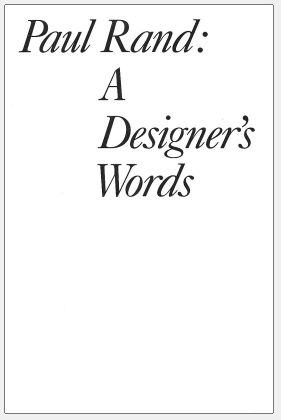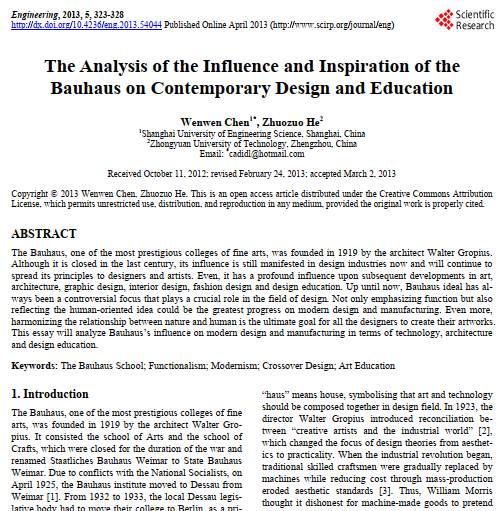Graphic Information Design: Graphic Design Influences
Graphic design is a discipline which focuses on visual communication and presentation. Various methods are used to create and combine symbols, images and/or words to create a tangible representation of ideas and messages. A graphic designer may utilise typography, visual arts and page layout techniques to achieve their task. Graphic design refers to both the process and the products which are generated. Text and pure design elements, such as shapes and colour, are used to unify the piece.

Good composition is the backbone of graphic design especially when using pre-existing materials or diverse elements. The language of graphic design is applied in virtually every organization or society. While graphic design as a term has a relatively recent history, graphic design activities span the history of humankind.
This article will take a whistle stop tour of some figures, key concepts and moments which have helped inform the discipline of graphic design.
The caves of Lascaux, Rome’s Trajan’s Column, manuscripts of the middle ages, the Rosetta Stone and Mexican weaving patterns all display key features of graphic design. Who originally coined the term “graphic design” appears to be vague but for many it has commonly been attributed to Richard Guyatt in 1948.
Guyatt was the youngest ever Professor at the Royal College of Art on his appointment in 1948; he was Rector from 1978 to `981. He acted as consultant designer to Wedgwood, WH Smith and other British companies. Guyatt also created coins for the Royal Mint as well as designed postage stamps for the Royal Mail.
Another significant figure in design earlier in 1849 was that of Henry Cole who informed the government of the importance of design in his Journal of Design and Manufactures. In the journal he put forward the view that design should encompass more than applied ornament but also knowledge of manufacturing processes and materials. He helped organize the Great Exhibition in 1851 as a celebration of modern industrial technology and Victorian design.
Around at the same time was Owen Jones, a London-born architect and designer of Welsh descent. He was an architect and designer, and one of the most influential design theorists of the nineteenth century. He developed a close working relationship with Henry Cole and formulated decorative arts principles which became teaching frameworks for the Government School of Design at Marlborough House. These design propositions also formed the basis for his seminal publication, The Grammar of Ornament; the global and historical design sourcebook for which Jones has become famous for today.
In late 19th century Europe, especially in the United Kingdom, the design industry started to separate from fine art. Piet Mondrian is one of the famous contributors to graphic design. He was a fine artist and a part of the De Stijl art movement and group, which was founded by Theo van Doesburg. He evolved a non-representational form which he termed Neo-Plasticism. This consisted of white ground, upon which a grid of vertical and horizontal black lines was painted in which he used the three primary colours. His use of grids developed the modern grid system commonly in use today in much of advertising, print and web layout.

Someone who greatly influenced the development of graphic design during the 19th century was William Morris. He designed two typefaces based on fifteenth-century models, the Roman “Golden” type (inspired by the typeface of the early Venetian printer Nicolaus Jenson) and the black letter “Troy” type; as well as a third type, the “Chaucer” which was an enlargement of the Troy type. He also designed floriated borders and initials for the books, drawing inspiration from incunabula and their woodcut illustrations.
From 1892 to 1896 William Morris’ Kelmscott Press published books that are some of the most significant historical graphic design products. The work of the Kelmscott Press is characterized by its focus on historical styles. This historicism was important as it was a significant reaction to the lack of innovation in nineteenth century graphic design. Morris’ work, along with the rest of the Private Press movement, directly influenced Art Nouveau and further influenced developments in early twentieth century graphic design.
Morris showed that a market existed for works of graphic design in their own right and helped to pioneer the separation of design from production and from fine art. The term ‘Private Press’ is used to refer to a movement in book production which flourished at the turn of the 19th and 20th centuries under the influence of William Morris, Sir Emery Walker and their followers. The movement is usually considered to have begun with the founding of Morris’ Kelmscott Press in 1890, following a lecture on printing given by Walker at the Arts and Crafts Exhibition Society in November 1888.
Those involved in the movement created books by traditional printing and binding methods, with an emphasis on the book as a work of art and manual skill, as well as a medium for the communication of information.
An alternative source for the coining of the term ‘Graphic Design’ comes from the United States in 1922. William Addison Dwiggins, a type designer, calligrapher, and book designer used the term to describe his various activities in printed communications. He attained recognition as an illustrator and commercial artist, and developed the typefaces Metro, Electra and Caledonia. He made a critique on contemporary book designers in An Investigation into the Physical Properties of Books (1919) led to his working with the publisher Alfred A. Knopf.
Another well known figure from around the same time was that of Edward Johnston, a British craftsman who is regarded, along with Rudolf Koch, as the a father of modern calligraphy. He was known for his use of the broad edged pen as a writing tool which gives rise to a particular form of calligraphy. He is most famous for designing the sans-serif Johnston typeface that was used throughout the London Underground system until it was re-designed in the 1980s. He is also known for his design of the famous roundel symbol used throughout the underground train system.
Constructivism and Purposeful Art
Constructivism was an artistic and architectural movement that originated in Russia from 1919 onwards, and which rejected the idea of “art for art’s sake” in favour of art as a practice directed towards social and constructive purposes. In the 1920s, Soviet constructivism applied ‘intellectual production’ in various areas of industry.
Many Constructivists worked on the design of posters to film. These are well represented by the brightly coloured, geometric jazz-age posters of the Stenberg brothers, and by the agitational photomontage work of Gustav Klutsis and Valentina Kulagina. The Constructivists’ main political patron was Leon Trotsky, however the movement came to be regarded with suspicion after the expulsion of Trotsky and the Left Opposition in 1927 to 1928. Various styles and techniques emerged from this period to help inform the field of graphic design.
Graphic design as a discipline has had its application in many areas of culture from road signs to technical schematics, from bureaucratic paperwork to reference manuals, all through its practical tenet to enhance the transfer of knowledge. Readability of information is enhanced by improving the visual presentation of text, and through this axiom graphic design has revolutionized how we encounter knowledge.
We can identify many of the developments of information graphic design by looking at common documents today. Famous examples are those of Haynes Manuals and common examples can be found throughout our lives, such as in those of manufacturers instructions as you see below. The aesthetics of knowledge are applied in these places to better communicate information which needs to be related within a context. With regards to gas heating, information has to be concise, accurate and intuitive so that complex processes such as fault finding can be followed and repair procedures correctly identified.
Take a moment to look through the manual below and see how they are communicating complicated, interrelated information:


Josef Müller-Brockmann was a Swiss graphic designer and teacher. He studied architecture, design and history of art in Zurich. In 1936 he opened a studio specialising in graphic design, exhibition design and photography. Müller-Brockmann became famous for designing posters in an austere yet accessible manner which came to be typical of the 1950s and 1960s era.
He was author of the 1961 publications ‘The Graphic Artist and his Design Problems‘ and ‘Grid Systems in Graphic Design‘ where he advocated for use of the grid for page structure; he also produced the 1971 publications ‘History of the Poster’ and ‘A History of Visual Communication’. He is recognised for his clean cut designs and his simple use of typography.
Graphic design has played a role in the development of entertainment, decoration, and visual story telling, amongst other things. Examples of design for entertainment purposes include novels, comic books, credit rolls in film, and events programs.
Adrian Frutiger is one of the well known typeface designers of the twentieth century, who continues influencing the direction of digital typography. Two prominent typefaces he created are those of Univers and Frutiger. Adrian Frutiger’s career spans the hot metal, phototypesetting, and digital typesetting eras.
Paul Rand (born Peretz Rosenbaum) was an American graphic designer and one of the originators of the Swiss Style of graphic design. He is best known for his corporate logo designs, including those of IBM, UPS, Westinghouse and ABC – to name but a few. He made significant contributions to the development of corporate identities such that people intuitively came to associate qualities, ideas and characteristics to the companies simply by looking at the symbols he engineered. Although his logos may be seen as simplistic, Rand explained in ‘A Designer’s Art‘ that “ideas do not need to be esoteric to be original or exciting”.
Paul Rand from the late 1930s onwards took the principles of the Bauhaus applying them to popular advertising and logo design thus creating his own interpretation of European minimalism.

Bauhaus Integration of Form and Function
The Bauhaus school was founded by Walter Gropius in Weimar. It was founded with the idea of creating a ‘total’ work of art in which all arts, including architecture would eventually be brought together. The Bauhaus style became one of the most influential forces in Modernist architecture and design. The Bauhaus has left a powerful legacy that has brought its influence to bear in the fields of graphic design, art, interior design, architecture, education and typography.
A great influence on Bauhaus was modernism – a cultural movement whose origins lay as far back as the 1880s. Modernism had made its presence felt in Germany before the first World War, despite the prominent conservatism of the time. The design innovations commonly associated with the school are simplified forms, rationality and functionality, and the idea that mass-production was reconcilable with the individual artistic spirit. These ideas were already seeded in German culture before the Bauhaus was formed and were brought together in the experimental project which Gropius and others pioneered.

Next Article





